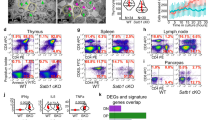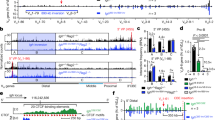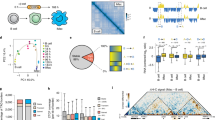Abstract
SATB1 (special AT-rich sequence binding protein 1) organizes cell type–specific nuclear architecture by anchoring specialized DNA sequences and recruiting chromatin remodeling factors to control gene transcription. We studied the role of SATB1 in regulating the coordinated expression of Il5, Il4 and Il13, located in the 200-kb T-helper 2 (TH2) cytokine locus on mouse chromosome 11. We show that on TH2 cell activation, SATB1 expression is rapidly induced to form a unique transcriptionally active chromatin structure at the cytokine locus. In this structure, chromatin is folded into numerous small loops, all anchored to SATB1 at their base. In addition, histone H3 is acetylated at Lys9 and Lys14, and the TH2-specific factors GATA3, STAT6 and c-Maf, the chromatin-remodeling enzyme Brg1 and RNA polymerase II are all bound across the 200-kb region. Before activation, the TH2 cytokine locus is already associated with GATA3 and STAT6, showing some looping, but these are insufficient to induce cytokine gene expression. Using RNA interference, we show that on cell activation, SATB1 is required not only for compacting chromatin into dense loops at the 200-kb cytokine locus but also for inducing Il4, Il5, Il13 and c-Maf expression. Thus, SATB1 is a necessary determinant for the hitherto unidentified higher-order, transcriptionally active chromatin structure that forms on TH2 cell activation.
This is a preview of subscription content, access via your institution
Access options
Subscribe to this journal
Receive 12 print issues and online access
$209.00 per year
only $17.42 per issue
Buy this article
- Purchase on Springer Link
- Instant access to full article PDF
Prices may be subject to local taxes which are calculated during checkout








Similar content being viewed by others
References
Jenuwein, T. & Allis, C.D. Translating the histone code. Science 293, 1074–1080 (2001).
Wilson, C.B., Makar, K.W., Shnyreva, M. & Fitzpatrick, D.R. DNA methylation and the expanding epigenetics of T cell lineage commitment. Semin. Immunol. 17, 105–119 (2005).
Kosak, S.T. & Groudine, M. Form follows function: The genomic organization of cellular differentiation. Genes Dev. 18, 1371–1384 (2004).
Dekker, J., Rippe, K., Dekker, M. & Kleckner, N. Capturing chromosome conformation. Science 295, 1306–1311 (2002).
Horike, S., Cai, S., Miyano, M., Cheng, J.F. & Kohwi-Shigematsu, T. Loss of silent-chromatin looping and impaired imprinting of DLX5 in Rett syndrome. Nat. Genet. 37, 31–40 (2005).
Tolhuis, B., Palstra, R.J., Splinter, E., Grosveld, F. & de-Laat, W. Looping and interaction between hypersensitive sites in the active beta-globin locus. Mol. Cell 10, 1453–1465 (2002).
Carter, D., Chakalova, L., Osborne, C.S., Dai, Y.F. & Fraser, P. Long-range chromatin regulatory interactions in vivo. Nat. Genet. 32, 623–626 (2002).
Palstra, R.J. et al. The beta-globin nuclear compartment in development and erythroid differentiation. Nat. Genet. 35, 190–194 (2003).
Drissen, R. et al. The active spatial organization of the beta-globin locus requires the transcription factor EKLF. Genes Dev. 18, 2485–2490 (2004).
Vakoc, C.R. et al. Proximity among distant regulatory elements at the beta-globin locus requires GATA-1 and FOG-1. Mol. Cell 17, 453–462 (2005).
Murrell, A., Heeson, S. & Reik, W. Interaction between differentially methylated regions partitions the imprinted genes Igf2 and H19 into parent-specific chromatin loops. Nat. Genet. 36, 889–893 (2004).
Kurukuti, S. et al. CTCF binding at the H19 imprinting control region mediates maternally inherited higher-order chromatin conformation to restrict enhancer access to Igf2. Proc. Natl. Acad. Sci. USA 103, 10684–10689 (2006).
Ling, J.Q. et al. CTCF mediates interchromosomal colocalization between Igf2/H19 and Wsb1/Nf1. Science 312, 269–272 (2006).
Liu, Z. & Garrard, W.T. Long-range interactions between three transcriptional enhancers, active Vkappa gene promoters, and a 3′ boundary sequence spanning 46 kilobases. Mol. Cell. Biol. 25, 3220–3231 (2005).
Wurtele, H. & Chartrand, P. Genome-wide scanning of HoxB1-associated loci in mouse ES cells using an open-ended Chromosome Conformation Capture methodology. Chromosome Res. 14, 477–495 (2006).
Spilianakis, C.G. & Flavell, R.A. Long-range intrachromosomal interactions in the T helper type 2 cytokine locus. Nat. Immunol. 5, 1017–1027 (2004).
Spilianakis, C.G., Lalioti, M.D., Town, T., Lee, G.R. & Flavell, R.A. Interchromosomal associations between alternatively expressed loci. Nature 435, 637–645 (2005).
Dickinson, L.A., Joh, T., Kohwi, Y. & Kohwi-Shigematsu, T. A tissue-specific MAR/SAR DNA-binding protein with unusual binding site recognition. Cell 70, 631–645 (1992).
Alvarez, J.D. et al. The MAR-binding protein SATB1 orchestrates temporal and spatial expression of multiple genes during T-cell development. Genes Dev. 14, 521–535 (2000).
de Belle, I., Cai, S. & Kohwi-Shigematsu, T. The genomic sequences bound to special AT-rich sequence-binding protein 1 (SATB1) in vivo in Jurkat T cells are tightly associated with the nuclear matrix at the bases of the chromatin loops. J. Cell Biol. 141, 335–348 (1998).
Cai, S., Han, H.J. & Kohwi-Shigematsu, T. Tissue-specific nuclear architecture and gene expression regulated by SATB1. Nat. Genet. 34, 42–51 (2003).
Yasui, D., Miyano, M., Cai, S., Varga-Weisz, P. & Kohwi-Shigematsu, T. SATB1 targets chromatin remodelling to regulate genes over long distances. Nature 419, 641–645 (2002).
Kohwi-Shigematsu, T. & Kohwi, Y. Torsional stress stabilizes extended base unpairing in suppressor sites flanking immunoglobulin heavy chain enhancer. Biochemistry 29, 9551–9560 (1990).
Wen, J. et al. SATB1 family protein expressed during early erythroid differentiation modifies globin gene expression. Blood 105, 3330–3339 (2005).
Britanova, O., Akopov, S., Lukyanov, S., Gruss, P. & Tarabykin, V. Novel transcription factor Satb2 interacts with matrix attachment region DNA elements in a tissue-specific manner and demonstrates cell-type-dependent expression in the developing mouse CNS. Eur. J. Neurosci. 21, 658–668 (2005).
Dobreva, G. et al. SATB2 is a multifunctional determinant of craniofacial patterning and osteoblast differentiation. Cell 125, 971–986 (2006).
Pavan Kumar, P. et al. Phosphorylation of SATB1, a global gene regulator, acts as a molecular switch regulating its transcriptional activity in vivo. Mol. Cell 22, 231–243 (2006).
Dobreva, G., Dambacher, J. & Grosschedl, R. SUMO modification of a novel MAR-binding protein, SATB2, modulates immunoglobulin mu gene expression. Genes Dev. 17, 3048–3061 (2003).
Glimcher, L.H. & Murphy, K.M. Lineage commitment in the immune system: the T helper lymphocyte grows up. Genes Dev. 14, 1693–1711 (2000).
Smale, S.T. & Fisher, A.G. Chromatin structure and gene regulation in the immune system. Annu. Rev. Immunol. 20, 427–462 (2002).
Ansel, K.M., Lee, D.U. & Rao, A. An epigenetic view of helper T cell differentiation. Nat. Immunol. 4, 616–623 (2003).
Fields, P.E., Kim, S.T. & Flavell, R.A. Cutting edge: changes in histone acetylation at the IL-4 and IFN-gamma loci accompany Th1/Th2 differentiation. J. Immunol. 169, 647–650 (2002).
Avni, O. et al. T(H) cell differentiation is accompanied by dynamic changes in histone acetylation of cytokine genes. Nat. Immunol. 3, 643–651 (2002).
Baguet, A. & Bix, M. Chromatin landscape dynamics of the Il4-Il13 locus during T helper 1 and 2 development. Proc. Natl. Acad. Sci. USA 101, 11410–11415 (2004).
Makar, K.W. et al. Active recruitment of DNA methyltransferases regulates interleukin 4 in thymocytes and T cells. Nat. Immunol. 4, 1183–1190 (2003).
Fields, P.E., Lee, G.R., Kim, S.T., Bartsevich, V.V. & Flavell, R.A. Th2-specific chromatin remodeling and enhancer activity in the Th2 cytokine locus control region. Immunity 21, 865–876 (2004).
Grosveld, F., van Assendelft, G.B., Greaves, D.R. & Kollias, G. Position-independent, high-level expression of the human beta-globin gene in transgenic mice. Cell 51, 975–985 (1987).
Lee, G.R., Fields, P.E., Griffin, T.J. & Flavell, R.A. Regulation of the Th2 cytokine locus by a locus control region. Immunity 19, 145–153 (2003).
Lee, G.R., Spilianakis, C.G. & Flavell, R.A. Hypersensitive site 7 of the TH2 locus control region is essential for expressing TH2 cytokine genes and for long-range intrachromosomal interactions. Nat. Immunol. 6, 42–48 (2005).
Kohwi-Shigematsu, T., deBelle, I., Dickinson, L.A., Galande, S. & Kohwi, Y. Identification of base-unpairing region-binding proteins and characterization of their in vivo binding sequences. Methods Cell Biol. 53, 323–354 (1998).
Loots, G.G. et al. Identification of a coordinate regulator of interleukins 4, 13, and 5 by cross-species sequence comparisons. Science 288, 136–140 (2000).
Zheng, W. & Flavell, R.A. The transcription factor GATA-3 is necessary and sufficient for Th2 cytokine gene expression in CD4 T cells. Cell 89, 587–596 (1997).
Zhu, J., Guo, L., Watson, C.J., Hu-Li, J. & Paul, W.E. Stat6 is necessary and sufficient for IL-4's role in Th2 differentiation and cell expansion. J. Immunol. 166, 7276–7281 (2001).
Kurata, H., Lee, H.J., O'Garra, A. & Arai, N. Ectopic expression of activated Stat6 induces the expression of Th2-specific cytokines and transcription factors in developing Th1 cells. Immunity 11, 677–688 (1999).
Ho, I.C., Hodge, M.R., Rooney, J.W. & Glimcher, L.H. The proto-oncogene c-maf is responsible for tissue-specific expression of interleukin-4. Cell 85, 973–983 (1996).
Zhao, K. et al. Rapid and phosphoinositol-dependent binding of the SWI/SNF-like BAF complex to chromatin after T lymphocyte receptor signaling. Cell 95, 625–636 (1998).
Paddison, P.J. et al. Cloning of short hairpin RNAs for gene knockdown in mammalian cells. Nat. Methods 1, 163–167 (2004).
Cook, P.R. Predicting three-dimensional genome structure from transcriptional activity. Nat. Genet. 32, 347–352 (2002).
Hager, G.L. et al. Chromatin dynamics and the evolution of alternate promoter states. Chromosome Res. 14, 107–116 (2006).
Kaye, J., Porcelli, S., Tite, J., Jones, B. & Janeway, C.A., Jr. Both a monoclonal antibody and antisera specific for determinants unique to individual cloned helper T cell lines can substitute for antigen and antigen-presenting cells in the activation of T cells. J. Exp. Med. 158, 836–856 (1983).
Acknowledgements
We thank N. Arai and S. Miyatake for instructing us on culturing D10.G4.1 cells, M. Kohwi for critically reading the manuscript and M. Miyano for drawing the loop model. This work was supported by US National Institutes of Health grants to T.K.-S.
Ethics declarations
Competing interests
The authors declare no competing financial interests.
Supplementary information
Supplementary Fig. 1
Cloning of genomic sequences that bind to SATB1 in vitro. (PDF 196 kb)
Supplementary Fig. 2
ChIP loop assay and 3C assay to determine chromatin structure of the TH2 cytokine locus. (PDF 2640 kb)
Supplementary Fig. 3
Primer sequences and DNA fragment sizes. (PDF 2079 kb)
Supplementary Fig. 4
Immunolocalization of RNA polymerase II, c-Maf, STAT6, Brg1 and SATB1 in resting and activated D10.G4.1 cells. (PDF 766 kb)
Supplementary Fig. 5
FISH analysis for the 200-kb cytokine region. (PDF 235 kb)
Rights and permissions
About this article
Cite this article
Cai, S., Lee, C. & Kohwi-Shigematsu, T. SATB1 packages densely looped, transcriptionally active chromatin for coordinated expression of cytokine genes. Nat Genet 38, 1278–1288 (2006). https://doi.org/10.1038/ng1913
Received:
Accepted:
Published:
Issue Date:
DOI: https://doi.org/10.1038/ng1913
This article is cited by
-
A dual function for the chromatin organizer Special A-T rich Binding Protein 1 in B-lineage cells
Cellular & Molecular Immunology (2023)
-
The role of transcription factors in shaping regulatory T cell identity
Nature Reviews Immunology (2023)
-
MicroRNA-495: a therapeutic and diagnostic tumor marker
Journal of Molecular Histology (2023)
-
Long Non-Coding RNA ANRIL Regulates Inflammatory Factor Expression in Ulcerative Colitis Via the miR-191-5p/SATB1 Axis
Inflammation (2023)
-
Chromatin organizer SATB1 controls the cell identity of CD4+ CD8+ double-positive thymocytes by regulating the activity of super-enhancers
Nature Communications (2022)



